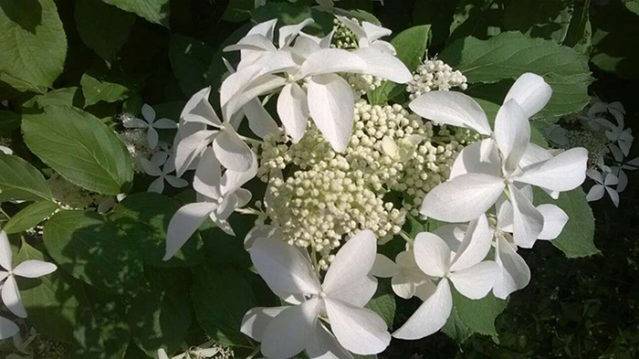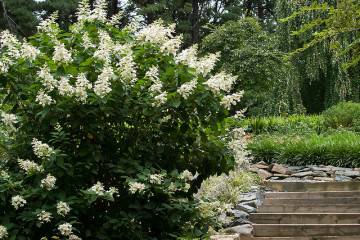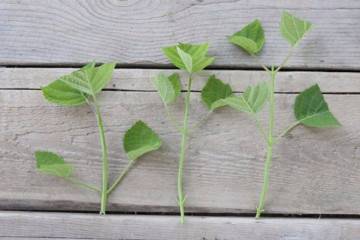Hydrangea Great Star paniculata (Great Star)
Content:
This is one of the most unusual varieties. Sterile flowers in inflorescences can reach 15 cm in diameter. They resemble bright stars in shape. Great Star in translation means "great star".
Origin, description of the Great Star hydrangea
A variety with a rich and long history, bred in a private garden Vastrival in France. The plant is a shrub up to 3 m in height with a compact crown 1.5-2 m in diameter. The bush has rough light brown shoots, dark green foliage.
Transplanting hydrangea Great Star after purchase in open ground
The hydrangea seedling is transferred to a permanent place in the garden in the spring.
What is needed for landing
For planting, you need a healthy seedling and the right place. The seedling must meet the following requirements:
- age 3-4 years;
- closed root system;
- without damage;
- without dried, rotten leaves;
- without signs of disease and pests.
Choosing the best place
The place where the Great Star hydrangea will be planted should be:
- well lit morning and evening. During the day, you need a light shade from buildings or trees;
- with well-drained acidic loam (pH 5-6).
Step-by-step planting process
Great Star panicle hydrangea is planted in open ground as follows:
- A day before planting, a planting hole is dug with a size slightly larger than the volume of the root system of the seedling.
- Water the hole abundantly.
- At the bottom of the hole, 20 cm of soil for hydrangeas is poured, mixed with 20 g of potassium sulfate, 20 g of urea, 60 g of superphosphate, forming a mound.
- The roots of the seedling are placed in a hole, sprinkled with soil, compacted.
- Water abundantly at the root.
- Mulch with covering material, bark, peat.
Reproduction of hydrangea Great Star
Hydrangea in the garden can be propagated generatively (by seeds) and vegetatively (by layering, dividing the bush, cuttings). The easiest option is to propagate by cuttings.
Propagation by cuttings
Cuttings can be cut from a healthy bush throughout the growing season. It must consist of at least two internodes. The lower end is cut at an acute angle and treated with a rooting stimulator.
The cuttings are buried in a mixture of sand and peat and set up a greenhouse. The substrate is kept moist. After 1.5 months, the cuttings will take root, and they can be transplanted to the site. For the winter, seedlings must be insulated with spunbond and spruce branches.
Growing from seeds
Seed propagation of hydrangeas is a laborious and painstaking process that does not always provide an accurate transfer of varietal characteristics.
Growing from seeds is performed according to the following algorithm:
- In the fall, seeds are sown in a container on the surface of the soil, they do not sprinkle with earth on top. Seedlings will appear in 4-5 weeks.
- Seedlings dive 2 times, selecting only the strongest ones.
- After picking, top dressing is carried out with specialized fertilizer for seedlings.
- Young hydrangeas are transplanted into open ground 1.5-2 years after sowing.
Hydrangea Care Great Star
If the planting of the Great Star panicle hydrangea was carried out according to all the rules, then leaving will be reduced to minimal, but mandatory measures.
Watering mode
Great Star is hygrophilous; in one watering, up to 30 liters of water are poured under an adult plant. Water once a week, in case of drought - 2-3 times. The soil near the bush should be slightly damp.
Top dressing
Top dressing is carried out 4 times per season:
- in early spring before the start of active sap flow. Use organic fertilizers such as mullein solution;
- during a set of colors. Hydrangeas need potassium and phosphorus. It is necessary to add 20 g of potassium sulfate and urea, 60 g of superphosphate for each bush;
- in the second decade of July. Complex fertilizers are used, liquid can be used;
- after the end of flowering. We need phosphorus and potassium.
Features of care during flowering
During the flowering period, the plant needs regular abundant watering. At the very beginning of the opening of the buds, you can feed the bushes with organic fertilizer and cut off the unopened outer inflorescences. This will enable the plant to form larger panicles.
Features of care during the rest period
During the rest period, the following agrotechnical measures are carried out:
- mulching. Covering the near-trunk circle, moisture will be retained longer in the soil. You can mulch with expanded clay, shavings, sawdust, vermiculite, bark. It is useful to plant shade-loving ground cover crops around the stem, for example, periwinkle, highlander, thyme;
- pruning. In the spring, sanitary or formative pruning is carried out. During the sanitary, sick, dry, damaged branches are removed, young shoots are shortened by 1-3 pairs of buds. Shaping allows you to give the bush an interesting shape. If there is a need to rejuvenate the plant, all stems are removed from it, leaving 5-6 cm each.
In the fall, the faded inflorescences are cut off.
Preparing for winter
Hydrangea Star is a frost-resistant variety. But, despite this, it is worth preparing the bushes for winter. For this:
- The trunk circle is mulched with peat, humus or fallen leaves.
- During the first snowfalls, the branches that are bent to the ground and fixed are covered with snow.
Great Star will perfectly cope with the role of a soloist in a flower bed and will look beautiful in a group. The bushes, planted in rows, form a spectacular curb or hedge. Often, hydrangeas are located along the banks of reservoirs. Wherever the beautiful Great Star hydrangea grows, everywhere it will attract attention and delight the eye.



















